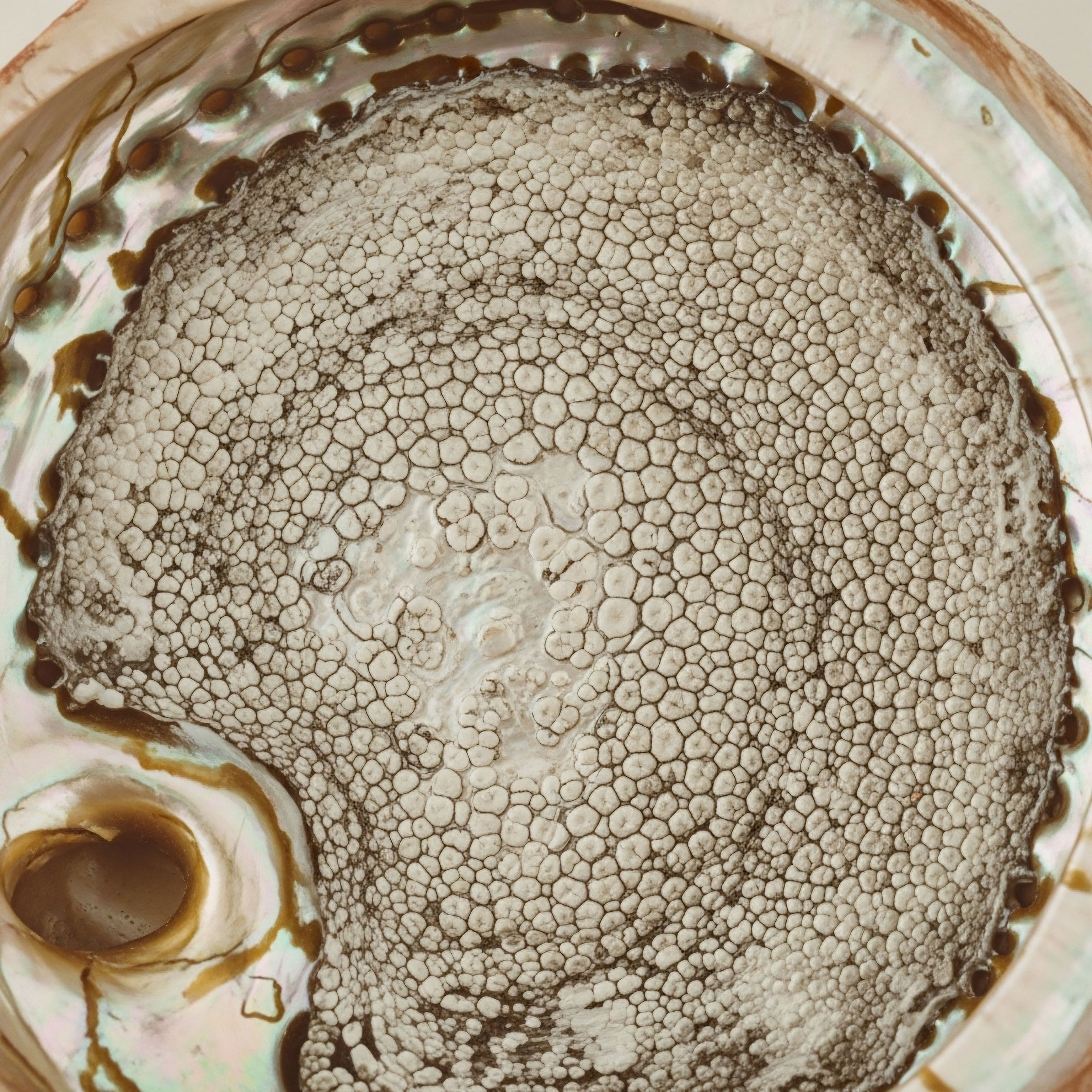

Fundamentals
The feeling is unmistakable. It is a subtle, creeping sense of disconnection from the body you once knew. The energy that once propelled you through demanding days now feels rationed. The reflection in the mirror shows a gradual softening, a redistribution of mass toward the midsection that seems indifferent to your efforts in the gym or with your diet.
This experience, this lived reality of fatigue, mental fog, and a changing physique, is not a personal failing. It is the clinical signature of a communication breakdown within your body’s most critical control system ∞ the endocrine network.
Your body operates through an intricate web of biochemical messages. Hormones are the primary agents of this communication, traveling through the bloodstream to deliver precise instructions to every cell, tissue, and organ. When this messaging system functions optimally, you experience vitality.
When the signals become weak, distorted, or are no longer received correctly, the system begins to lose its coherence. The result is the very collection of symptoms that prompted you to seek answers. Understanding how to restore this internal dialogue is the first step toward reclaiming your metabolic and hormonal health.

The Foundational Signal Testosterone
Testosterone functions as a powerful, system-wide broadcast. This androgenic hormone sends a clear and persistent signal to tissues throughout the body, instructing them to maintain an anabolic state. This means it directs the body to build and preserve metabolically active tissues, primarily muscle.
Simultaneously, it supports neurological function, influences mood and motivation, and plays a direct role in regulating how your body utilizes and stores energy. A decline in testosterone levels means this foundational signal weakens. The instructions to maintain muscle mass become faint, the directive to manage fat storage becomes confused, and the overall sense of vitality diminishes. Restoring testosterone to an optimal physiological range re-establishes this clear, powerful, and body-defining broadcast.
Optimizing testosterone provides the systemic hormonal foundation required for efficient metabolic function and physical resilience.

The Action-Oriented Messenger Growth Hormone
Working in concert with testosterone is the growth hormone (GH) and insulin-like growth factor 1 (IGF-1) axis. You can conceptualize the pituitary gland as a specialized communication hub. It releases pulses of GH in response to signals from the hypothalamus.
GH then travels to the liver and other tissues, prompting the release of IGF-1, the molecule that carries out many of GH’s most important metabolic actions. These actions include stimulating the breakdown of stored fat (lipolysis) and supporting the repair and growth of tissues. Peptides are small proteins that act as highly specific signaling molecules.
Certain therapeutic peptides, known as secretagogues, are designed to communicate directly with the pituitary gland, prompting it to release your own natural GH in a manner that mimics your body’s youthful, rhythmic pulses. This targeted messaging amplifies the body’s capacity for repair and metabolic regulation.
The question of combining these therapies moves us toward a more complete strategy. By pairing the broad, foundational signal of testosterone with the precise, action-oriented messages of peptides, we can create a more comprehensive and synergistic effect. The goal is to restore not just one part of the system, but the coherence of the entire endocrine conversation, leading to enhanced metabolic outcomes that are often difficult to achieve with either approach alone.


Intermediate
Advancing from a foundational understanding of hormonal communication to a clinical application requires a detailed look at the specific tools used to restore this dialogue. A well-designed protocol is a strategic intervention, using precise molecules to send clear signals to specific biological targets.
The objective is to re-establish the body’s innate physiological rhythms and feedback loops. When combining testosterone optimization with peptide therapies, the protocol becomes a multi-layered communication strategy designed for comprehensive metabolic recalibration. Testosterone sets the essential anabolic baseline, while peptides provide targeted, pulsatile signals that direct specific metabolic activities.

Architecting the Testosterone Foundation
A typical Testosterone Replacement Therapy (TRT) protocol for men is designed to restore serum testosterone to a healthy, youthful range, thereby re-establishing its critical systemic signal. This involves more than just administering testosterone; it requires managing its downstream effects to maintain balance within the Hypothalamic-Pituitary-Gonadal (HPG) axis. The components work together to create a stable and effective hormonal environment.
For women experiencing symptoms of hormonal decline, a much lower dose of testosterone can be instrumental in restoring energy, libido, and metabolic control. The approach is tailored to a woman’s specific physiology, often complementing other hormonal support like progesterone.
| Component | Mechanism of Action | Clinical Purpose |
|---|---|---|
| Testosterone Cypionate | A slow-acting ester of testosterone, administered via intramuscular or subcutaneous injection. It provides a steady, stable elevation of serum testosterone levels. | Serves as the primary replacement hormone, restoring the foundational anabolic and metabolic signal that has diminished with age or medical conditions. |
| Gonadorelin | A synthetic analog of Gonadotropin-Releasing Hormone (GnRH). It stimulates the pituitary gland to release Luteinizing Hormone (LH) and Follicle-Stimulating Hormone (FSH). | Prevents testicular atrophy and preserves a degree of natural testosterone production and fertility by keeping the HPG axis active, even while receiving exogenous testosterone. |
| Anastrozole | An aromatase inhibitor. It blocks the enzyme aromatase, which converts testosterone into estrogen. | Manages estrogen levels to prevent potential side effects like water retention or gynecomastia, ensuring the testosterone-to-estrogen ratio remains optimal for male physiology. |

Deploying Targeted Peptide Messengers
With the testosterone foundation in place, peptide therapies are introduced to fine-tune metabolic outcomes. These peptides are growth hormone secretagogues, meaning they signal the pituitary gland to release endogenous growth hormone (GH). This approach is fundamentally different from direct injection of synthetic HGH. It preserves the body’s natural pulsatile release of GH, which is crucial for efficacy and safety. This rhythmic signaling is what the body is designed to recognize and respond to.
Peptide secretagogues work by amplifying the body’s own natural growth hormone pulses, leading to more physiological and targeted metabolic effects.
The synergy arises from this dual approach. Testosterone provides a constant anabolic pressure, encouraging muscle protein synthesis and improving insulin sensitivity. The peptide-induced GH pulses then act upon this primed system, dramatically accelerating the breakdown of stored fat, particularly visceral adipose tissue, and enhancing tissue repair. The two therapies work on different, yet complementary, cellular pathways to achieve a common goal.

What Are the Different Types of Peptide Secretagogues?
Different peptides have distinct mechanisms of action and are selected based on the specific clinical goals for the individual. The most common and effective protocols often combine two types of peptides to maximize the GH pulse.
- Growth Hormone-Releasing Hormones (GHRH) ∞ These peptides, such as Sermorelin, CJC-1295, and Tesamorelin, bind to the GHRH receptor on the pituitary gland. They directly stimulate the synthesis and release of GH. They are the primary “go” signal.
- Growth Hormone-Releasing Peptides (GHRP) ∞ These peptides, including Ipamorelin and Hexarelin, have a dual action. They bind to a separate receptor (the ghrelin receptor) to amplify the GHRH signal, and they also suppress somatostatin, the hormone that acts as a brake on GH release. Combining a GHRH with a GHRP removes the “brake” while pressing the “accelerator,” resulting in a powerful and synergistic GH pulse.
| Peptide Protocol | Primary Mechanism | Key Metabolic Outcomes | Best Suited For |
|---|---|---|---|
| Sermorelin | A GHRH analog that stimulates a natural, pulsatile release of GH. It has a short half-life, mimicking the body’s own signaling rhythm. | General improvements in body composition, enhanced recovery, improved sleep quality, and increased lean muscle mass. A good introductory peptide. | Individuals seeking overall anti-aging benefits, improved recovery from exercise, and moderate fat loss alongside TRT. |
| CJC-1295 / Ipamorelin | A synergistic combination. CJC-1295 (a GHRH) provides a strong stimulus for GH release, while Ipamorelin (a GHRP) amplifies that pulse and suppresses somatostatin. | Potent effects on muscle growth (anabolism) and fat loss (lipolysis). Significant improvements in sleep, recovery, and overall body composition. | Individuals focused on maximizing muscle gain and fat reduction, seeking a powerful synergistic effect to complement their TRT protocol. |
| Tesamorelin | A potent GHRH analog with a strong affinity for its receptor. It is clinically proven and FDA-approved to reduce visceral adipose tissue (VAT). | Targeted and significant reduction of deep abdominal fat. Improvements in triglyceride levels and other metabolic markers associated with visceral obesity. | Individuals whose primary concern is excess visceral fat, a key driver of metabolic syndrome, insulin resistance, and cardiovascular risk. |
A combined protocol of TRT and a peptide like Tesamorelin represents a highly sophisticated clinical strategy. The testosterone works systemically to improve the body’s underlying metabolic machinery and insulin sensitivity. Concurrently, Tesamorelin sends a targeted, powerful signal to mobilize and burn the most dangerous type of body fat. This multi-pronged approach addresses both the systemic hormonal environment and a specific, critical metabolic target, leading to outcomes that are superior to what could be achieved with a single therapy.


Academic
A comprehensive analysis of the synergy between testosterone optimization and peptide therapies requires an examination of the molecular interactions within key metabolic tissues. The enhanced clinical outcomes observed are not merely an additive effect of two separate mechanisms.
They are the result of intricate biochemical cross-talk between the androgen receptor (AR) signaling pathway and the growth hormone/insulin-like growth factor-1 (GH/IGF-1) axis. This interplay is most pronounced in skeletal muscle and adipose tissue, the primary sites of metabolic regulation and body composition changes. Understanding this molecular dialogue explains why a combined therapeutic strategy can produce superior results in protein anabolism and lipolysis.

Androgen Receptor Priming of Myocellular Anabolism
Testosterone exerts its primary anabolic effects in skeletal muscle through its binding to the intracellular androgen receptor. This hormone-receptor complex translocates to the nucleus and functions as a transcription factor, directly upregulating the expression of genes involved in muscle protein synthesis.
This includes genes for key contractile proteins like actin and myosin, as well as the IGF-1 gene itself, specifically the muscle-specific isoform known as mechano-growth factor (MGF). By increasing the local expression of MGF and sensitizing the IGF-1 receptor (IGF-1R) on the myocyte surface, testosterone creates a cellular environment that is highly receptive to anabolic signals.
Testosterone directly primes muscle cells for growth by increasing the genetic expression of anabolic factors and enhancing receptor sensitivity.
This “priming” effect is a critical component of the synergy. When a peptide secretagogue like CJC-1295/Ipamorelin induces a systemic pulse of GH, the liver responds by producing and releasing endocrine IGF-1 into circulation. This circulating IGF-1 arrives at muscle tissue that has already been transcriptionally prepared by testosterone to respond with maximal efficiency.
The result is a potentiation of the downstream signaling cascade, including the activation of the PI3K/Akt/mTOR pathway, the central regulator of muscle protein synthesis. Studies in hypopituitary men have demonstrated that while testosterone alone can increase nonoxidative leucine disposal (a measure of protein synthesis), the effect is significantly augmented when GH is added. The testosterone creates the potential for growth; the peptide-induced GH/IGF-1 pulse actualizes it.

Coordinated Regulation of Adipose Tissue Lipolysis
In adipose tissue, particularly visceral depots, testosterone and the GH/IGF-1 axis exert coordinated control over lipid metabolism. Visceral adipocytes are highly sensitive to hormonal signals. Excess visceral adipose tissue (VAT) is characterized by a state of low-grade, chronic inflammation and insulin resistance. Both testosterone and GH are known to counteract these pathological processes.
Testosterone has been shown to directly inhibit lipid uptake and differentiation of pre-adipocytes into mature fat cells, effectively limiting the storage capacity of adipose tissue. It also appears to increase the density of β-adrenergic receptors on adipocytes, the same receptors that respond to catecholamines (like adrenaline) to initiate fat breakdown. This makes fat cells more responsive to lipolytic signals.

How Does Tesamorelin Specifically Target Visceral Fat?
Peptide therapies, especially a potent GHRH analog like Tesamorelin, provide the primary lipolytic stimulus. GH binds to its receptor (GHR) on adipocytes, triggering a cascade that leads to the phosphorylation and activation of Hormone-Sensitive Lipase (HSL) and Adipose Triglyceride Lipase (ATGL).
These are the rate-limiting enzymes in the process of lipolysis, which breaks down stored triglycerides into free fatty acids and glycerol, allowing them to be released from the fat cell and oxidized for energy. Clinical trials have unequivocally demonstrated Tesamorelin’s efficacy in reducing VAT in various populations. The peptide provides the powerful “release” signal.
The synergy in fat reduction comes from this coordinated attack. Testosterone works to limit fat storage and increase the sensitivity of the fat cell to breakdown signals. Tesamorelin then provides a potent, pulsatile signal that activates the enzymatic machinery for fat breakdown.
This dual-action mechanism explains the profound and targeted reduction in visceral fat observed in combined therapy protocols. The testosterone-optimized environment is more metabolically efficient, and the peptide-driven GH pulse provides the specific catabolic trigger to mobilize stored energy from the most metabolically harmful fat depots.
- Systemic Anabolic Support ∞ Testosterone administration establishes a baseline of increased protein synthesis, improved insulin sensitivity, and a systemic environment conducive to lean mass accretion.
- Pulsatile GH Release ∞ Peptide secretagogues stimulate a physiological, pulsatile release of endogenous GH, which is critical for activating downstream pathways without causing the receptor desensitization associated with continuous high levels of GH.
- Molecular Synergy in Muscle ∞ In myocites, AR activation upregulates local IGF-1 production and sensitizes IGF-1 receptors, amplifying the anabolic signal delivered by the peptide-induced IGF-1 pulse.
- Coordinated Lipolysis in Adipose Tissue ∞ In adipocytes, testosterone limits lipid storage and enhances lipolytic sensitivity, while the GH pulse provides the potent enzymatic trigger for the breakdown of triglycerides, especially in visceral fat.
This systems-biology perspective demonstrates that combining these therapies is a sophisticated clinical intervention. It leverages distinct but interconnected pathways to restore a more youthful and efficient metabolic state. The approach addresses both the foundational hormonal milieu and the specific, pulsatile signaling required for optimal body composition and metabolic health.

References
- Sinha, D. K. et al. “Beyond the androgen receptor ∞ the role of growth hormone secretagogues in the modern management of body composition in hypogonadal males.” Translational Andrology and Urology, vol. 9, suppl. 2, 2020, pp. S195-S203.
- Falutz, Julian, et al. “Effects of Tesamorelin, a Growth Hormone ∞ Releasing Factor Analog, in HIV-Infected Patients With Abdominal Fat Accumulation ∞ A Randomized, Placebo-Controlled Trial With a Safety Extension.” Journal of Acquired Immune Deficiency Syndromes, vol. 56, no. 4, 2011, pp. 329-337.
- Giannoulis, M. G. et al. “The effects of growth hormone and/or testosterone in healthy elderly men ∞ a randomized controlled trial.” Journal of Clinical Endocrinology & Metabolism, vol. 91, no. 2, 2006, pp. 477-484.
- Blackman, Marc R. et al. “Effects of Growth Hormone and/or Testosterone in Healthy Older Men.” JAMA, vol. 288, no. 18, 2002, pp. 2282-2292.
- Mulligan, Kathleen, et al. “Effects of Tesamorelin on Nonalcoholic Fatty Liver Disease in HIV-Infected Patients ∞ A Randomized, Double-Blind, Placebo-Controlled Trial.” The Lancet HIV, vol. 3, no. 6, 2016, pp. e260-e268.
- Yuen, Kevin C. J. et al. “American Association of Clinical Endocrinologists and American College of Endocrinology Guidelines for Management of Growth Hormone Deficiency in Adults and Patients Transitioning From Pediatric to Adult Care.” Endocrine Practice, vol. 25, no. 11, 2019, pp. 1191-1232.
- Bhasin, Shalender, et al. “Testosterone Therapy in Men With Hypogonadism ∞ An Endocrine Society Clinical Practice Guideline.” Journal of Clinical Endocrinology & Metabolism, vol. 103, no. 5, 2018, pp. 1715-1744.
- Walker, R. F. “Sermorelin ∞ a better approach to management of adult-onset growth hormone insufficiency?” Clinical Interventions in Aging, vol. 1, no. 4, 2006, pp. 307-308.
- Sigalos, J. T. and L. I. Lipshultz. “The role of growth hormone secretagogues in the correction of hypogonadism.” Translational Andrology and Urology, vol. 5, no. 6, 2016, pp. 832-837.
- Veldhuis, Johannes D. and Ali Iranmanesh. “Physiological regulation of the human growth hormone (GH)-insulin-like growth factor type I (IGF-I) axis ∞ predominant impact of age, obesity, gonadal function, and sleep.” Sleep, vol. 19, no. 10, 1996, pp. S221-S224.

Reflection

Recalibrating Your Personal System
The information presented here provides a map of the intricate biological systems that govern your metabolic health. It details the molecules, the pathways, and the clinical strategies designed to restore function. This knowledge is a powerful tool, shifting the perspective from one of managing disparate symptoms to one of understanding and recalibrating an interconnected system.
The fatigue, the changes in body composition, and the mental cloudiness are not isolated events. They are data points, signaling a disruption in a finely tuned network.
Consider your own experience as a unique dataset. The way you feel, the changes you observe, and the results of your lab work all form a picture of your individual hormonal and metabolic state. The path forward involves using this personalized information to make informed decisions.
The science of hormonal optimization offers a framework for intervention, but the application of that science is deeply personal. Your body’s response, your goals, and your lived experience are the most important variables in this equation. The journey toward reclaimed vitality begins with this synthesis of objective science and subjective awareness, empowering you to become an active participant in the restoration of your own biological coherence.



